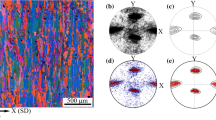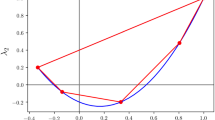Abstract
An approach based on Monte Carlo simulations for sampling crystallite orientations from known texture data is developed. A randomized algorithm is proposed to reconstruct the orientation distribution function by a given set of pole densities. The algorithm fills up the orientation space with lots of uniformly distributed points and tries to evaluate the reconstructable function specifically at these points. This leads to a sparse quadratic programming problem, which is a discrete statistical analogue of the fundamental equation of Texture Analysis. The resulted distribution is represented as a weighted sample of orientations, with the weights equal to the reconstructed distribution function values. By means of randomized weight-based selections, such a sample can be reduced to an unweighted one with appropriately distributed orientations. A theoretical substantiation of the methods is presented in the paper in the weak probabilistic sense. Several examples of practical applications are provided as well.







Similar content being viewed by others
REFERENCES
L. Anand, ‘‘Single-crystal elasto-viscoplasticity: Application to texture evolution in polycrystalline metals at large strains,’’ Comput. Methods Appl. Mech. Eng. 193, 5359–5383 (2004).
D. L. McDowell and G. B. Olson, ‘‘Concurrent design of hierarchical materials and structures,’’ Lect. Notes Comput. Sci. Eng. 68, 207–240 (2008).
P. van Houtte, ‘‘Crystal plasticity based modelling of deformation textures,’’ in Microstructure and Texture in Steels (Springer, Berlin, 2009), pp. 209–224.
F. Roters, P. Eisenlohr, L. Hantcherli, D. D. Tjahjanto, T. R. Bieler, and D. Raabe, ‘‘Overview of constitutive laws, kinematics, homogenization and multiscale methods in crystal plasticity finite-element modeling: Theory, experiments, applications,’’ Acta Mater. 58, 1152–1211 (2010).
P. V. Trusov and A. I. Shveykin, Multilevel Models of Mono- and Polycrystalline Materials: Theory, Algorithms, Application Examples (SO RAN, Novosibirsk, Russia, 2019) [in Russian].
L. Devroye, Non-Uniform Random Variate Generation (Springer, New York, NY, 1986).
H. J. Bunge, Texture Analysis in Materials Science (Butterworth-Heinemann, London, 1982).
A. Morawiec, Orientations and Rotations. Computations in Crystallographic Textures (Springer, Berlin, 2004).
D. Chateigner, Combined Analysis (ISTE, London, 2013).
S. Suwas and R. K. Ray, Crystallographic Texture of Materials (Springer, London, 2014).
C. Esling, E. Bechlerferry, and H. J. Bunge, ‘‘Numerical calculation of the odd part of the texture function,’’ J. Phys. Lett. 42, 141–144 (1981).
H. P. Van, ‘‘The use of a quadratic form for the determination of nonnegative texture functions,’’ Textures Microstruct. 6, 1–19 (1983).
M. Dahms and H. J. Bunge, ‘‘A positivity method for the determination of complete orientation distribution functions,’’ Textures Microstruct. 10, 21–35 (1988).
F. Wang, J. Z. Xu, and Z. D. Liang, ‘‘Determination of the ODF of hexagonal symmetry materials according to the maximum-entropy method,’’ Textures Microstruct. 10, 217–226 (1989).
F. Wang, J. Z. Xu, and Z. D. Liang, ‘‘Determination of the complete ODF of cubic system materials by the maximum-entropy method,’’ Textures Microstruct. 19, 55–58 (1992).
H. Schaeben and H. Siemes, ‘‘Determination and interpretation of preferred orientation with texture goniometry: An application of indicators to maximum entropy pole- to orientation density inversion,’’ Math. Geol. 28, 169–201 (1996).
L. Lucke, J. Pospiech, J. Jura, and J. Hirsch, ‘‘On the presentation of orientation distribution functions by model functions,’’ Z. Metall. 77, 312–321 (1986).
K. Helming and T. Eschner, ‘‘A new approach to texture analysis of multiphase materials using a texture component model,’’ Cryst. Res. Technol. 25, 203–208 (1990).
T. Eschner and J. J. Fundenberger, ‘‘Application of anisotropic texture components,’’ Textures Microstruct. 28, 181–195 (1997).
T. M. Ivanova, T. I. Savyolova, and M. V. Sypchenko, ‘‘The modified component method for calculation of orientation distribution function from pole figures,’’ Inverse Probl. Sci. Eng. 18, 163–171 (2010).
L. K. Jetter, C. J. McHargue, and R. O. Williams, ‘‘Method of representing preferred orientation data analysis,’’ J. Appl. Phys. 27, 368–374 (1956).
R. O. Williams, ‘‘Analytical methods for representing complex textures by biaxial pole figures,’’ J. Appl. Phys. 39, 4329–4335 (1968).
J. Imhof, ‘‘Determination of an approximation of orientation distribution function using one pole figure,’’ Z. Metall. 68, 38–43 (1977).
S. Matthies and G. W. Vinel, ‘‘On the reproduction of the orientation distribution function of texturized samples from reduced pole figures using the conception of a conditional ghost correction,’’ Phys. Status Solidi B 122, K111–K114 (1982).
S. Matthies and G. W. Vinel, ‘‘An example demonstrating a new reproduction method of the ODF of texturized samples from reduced pole figures,’’ Phys. Status Solidi B 112, 115–120 (1982).
D. Ruer and R. Baro, ‘‘Vectorial method of texture analysis of cubic lattice polycrystalline material,’’ J. Appl. Crystallogr. 10, 458–464 (1977).
A. Vadon and J. J. Heizmann, ‘‘A new program to calculate the texture vector for the vector method,’’ Textures Microstruct. 14, 37–44 (1991).
K. Pawlik, J. Pospiech, and K. Lucke ‘‘The ODF approximation from pole figures with the aid of the ADC method,’’ Textures Microstruct. 14, 25–30 (1991).
J. Tarasiuk, K. Wierzbanowski, and A. Baczmanski, ‘‘New algorithm of direct method of texture analysis,’’ Cryst. Res. Technol. 33, 101–118 (1998).
D. P. Kroese, T. Taimre, and I. B. Zdravko, Handbook of Monte Carlo Methods (Wiley, New York, 2011).
P. R. Halmos, Measure Theory (Springer, New York, NY, 1974).
M. Reed and B. Simon, Methods of Modern Mathematical Physics. I: Functional Analysis, 1st ed. (Academic, Cambridge, MA, 1980).
P. Billingsley, Probability and Measure (Wiley, New York, 1995).
J. H. Radon, ‘‘On the determination of functions from their integral values along certain manifolds,’’ IEEE Trans. Med. Imaging 5 (4), 170–176 (1986).
H. Schaeben and K. G. van den Boogaart, ‘‘Spherical harmonics in texture analysis,’’ Tectonophysics 370, 253–268 (2003).
K. Kunze and H. Schaeben, ‘‘The Bingham distribution of quaternions and its spherical radon transform in texture analysis,’’ Math. Geol. 36, 917–943 (2004).
A. N. Tikhonov and V. Ya. Arsenin, Methods of Solution of Ill-Posed Problems (Nauka, Moscow, 1979) [in Russian].
M. J. J. Evans and J. S. Rosenthal, Probability and Statistics: The Science of Uncertainty (W. H. Freeman, San Francisco, 2009).
A. Kumar and P. R. Dawson, ‘‘Modeling crystallographic texture evolution with finite elements over neo-Eulerian orientation spaces,’’ Comput. Methods Appl. Mech. Eng. 153, 259–302 (1998).
A. Heinz and P. Neumann, ‘‘Representation of orientation and disorientation data for cubic, hexagonal, tetragonal and orthorhombic crystals,’’ Acta Crystallogr., A 47, 780–789 (1991).
H. Weyl, The Classical Groups: Their Invariants and Representations, 2nd ed. (Princeton Univ. Press, Princeton, NJ, 1966).
Mingyan Sun, Qichao Fan, Yingying Wang, Qin Yang, Jie Chen, Shuke Huang, and Yonghao Zhang, ‘‘111<110> orientation induced anisotropy of shape memory effect in NiTiNb pipe joints,’’ Metals 10, 776 (2020).
Funding
This study was carried out with a financial support from the Ministry of Education and Science of the Russian Federation (the basic part of the PNRPU state assignment, project no. FSNM-2020-0027) and the Russian Foundation for Basic Research and Perm Territory (project no. 20-41-596002).
Author information
Authors and Affiliations
Corresponding authors
Additional information
(Submitted by A. M. Elizarov)
Rights and permissions
About this article
Cite this article
Ostapovich, K.V., Trusov, P.V. On Using Monte Carlo Simulations for Sampling Crystallite Orientations from Given Texture Data. Lobachevskii J Math 43, 1962–1975 (2022). https://doi.org/10.1134/S1995080222100328
Received:
Revised:
Accepted:
Published:
Issue Date:
DOI: https://doi.org/10.1134/S1995080222100328




